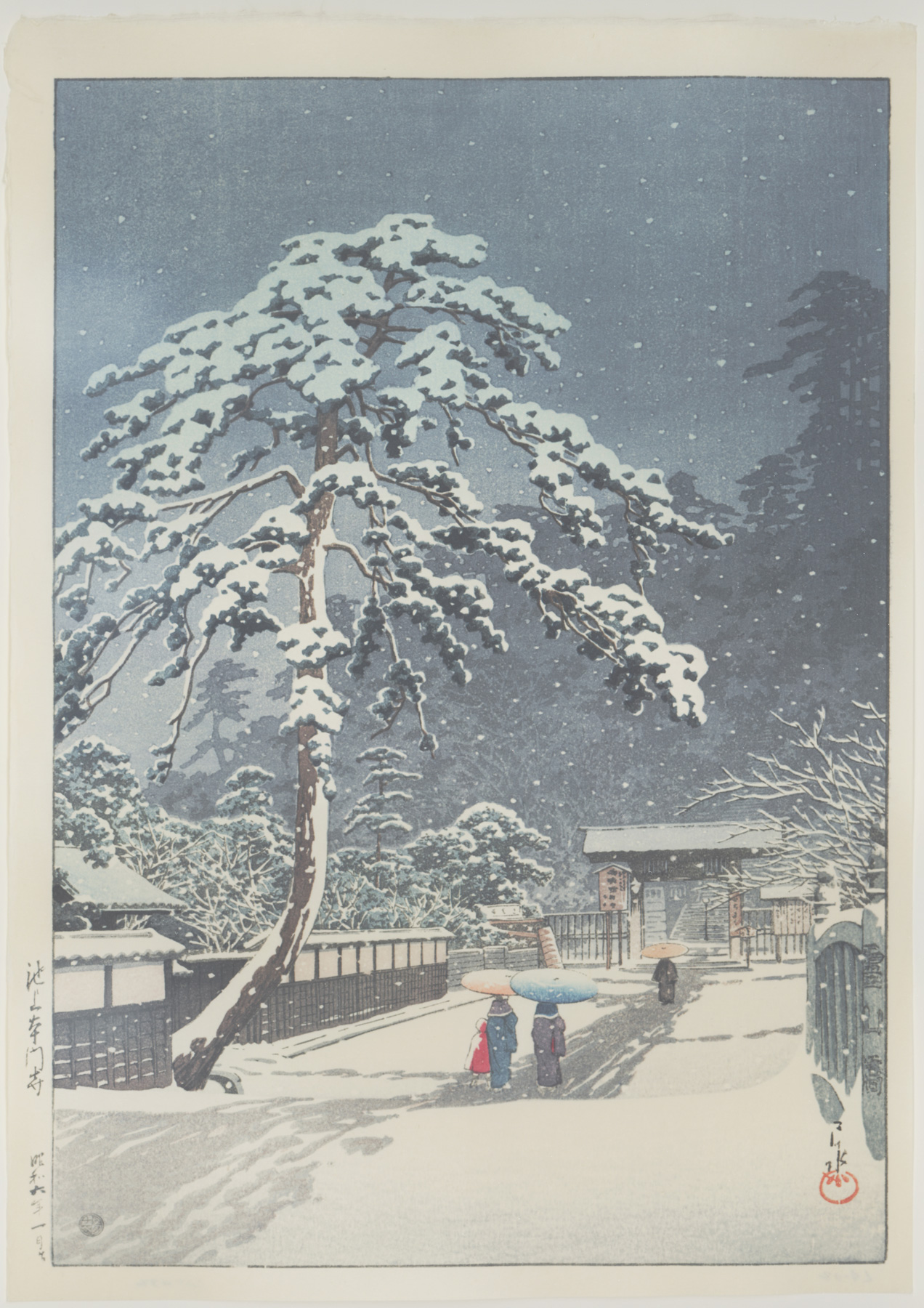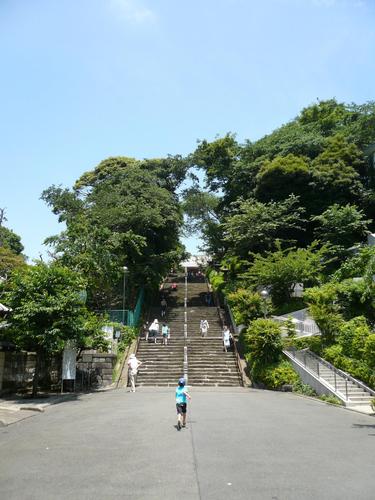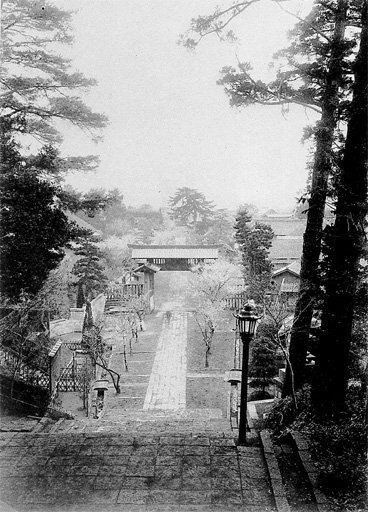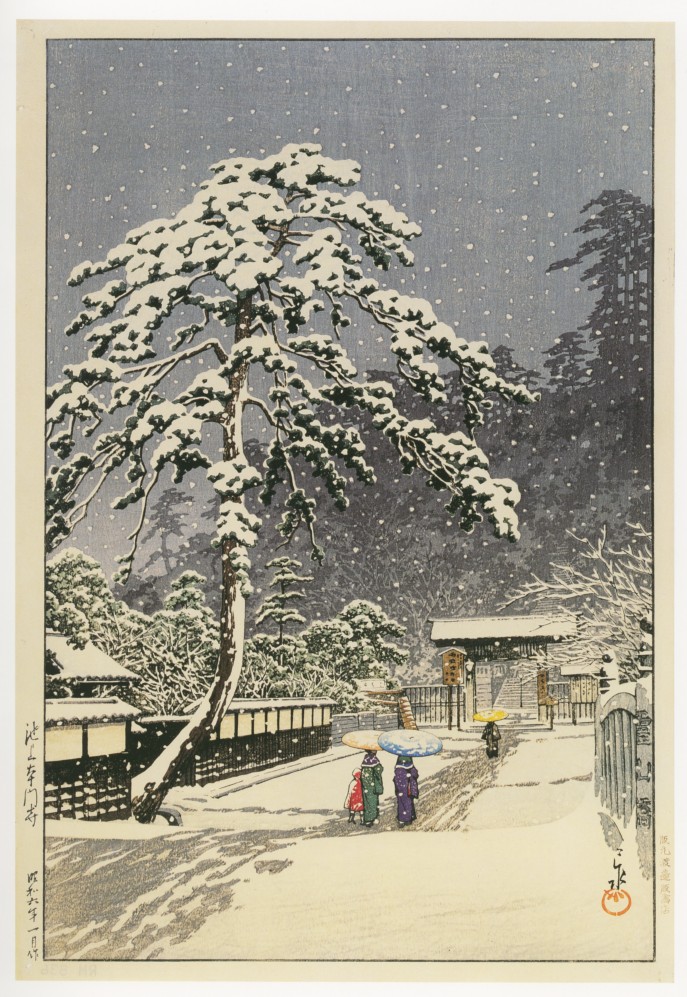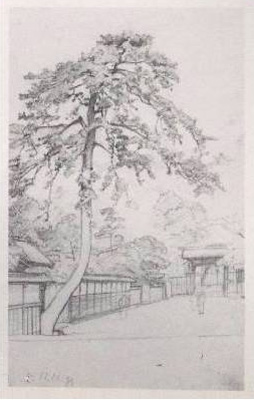About This Print
Catalog Raisonné Entry
Source: Kawase Hasui; TheComplete Woodblock Prints, Brown, Kendall; Amy Reigle Newland, Amsterdam, Hotei Publishing, KITPublishers, 2003, p. 88.Narazaki1 (Hasui's biographer) believes that “There are few unsuccessfulsnowscapes by Hasui and in this regard he equals Hiroshige(1797-1858). The treatment of the faint, distant snow-coveredmountains, the centrally positioned pine, which heightens the sentimentof the piece; and the path leading to the Honmon temple in the vicinityof the Rezan bridge has the feeling of a sketch.”
The Honmon temple is in Ikegami, Tokyo.
1 Narazaki Muneshige, Hasui's biographer and compiler of the artist's first catalogue raisoneeé Kawase Hasui mokuhanga shu, Mainichi Shinbun, Tokyo, 1979.
This design was oneof 111 by Hasui that were shown in the second shin hanga exhibition atthe Toledo Museum of Art in 1936. Ninety-one of his landscapes wereexhibited in 1930. Hasui's presence in these exhibitions (thirty-twopercent of the total prints shown) attests to the popularity of hisdesigns among Western consumers.
Locatedin the Ikegami district of Tokyo, the Honmon-ji marks the site whereNichiren, the founder of the nichiren sect of Buddhism, died in 1282. The original temple was completed in 1317 but rebuilt after it wasdestroyed by fire in 1710. Hasui does not depict the temple butinstead shows the approach to it over the Reizan Bridge, identified bythe stone posts of the bridge railing in the lower left corner. Thedesign is sparsely populated, but the well-worn footpath through thenewly fallen snow hints at the popularity of this famous site.
Theidyllic country scenes and the historic temples of Kyoto and Nara,often depicted by shin hanga artists, can be understood as a reactionto rapid urbanization in the early twentieth century. Temple andshrine precincts within the city of Tokyo were also illustrated withthis context in mind. Men are absent from these landscapes becausetheir westernized dress ran contrary to the underlying sentiments ofthe imagery. Women tended to retain the traditional dress of Japanand, hence, were featured in these prints.
THE TEMPLE HOMMON-JI AT IKEGAME [Ikegami Hommon-ji]
A gateway of the Buddhist temple called Hommon-ji, with a family of Buddhist devotees visiting the temple on a snowy day.
Signed. Hasui; red seal, decorative form only. Left margin: the Japanese title; and the date, "Showa Roku Nen Ichi Gatsu Saki" (Made in the 1st Month of the 6th Year of Showa [January 1931]. Right margin: copyright stamp of the publisher, Watanabe of Tokyo, Blocks, 20; superimposed printings, 25; edition, 300.
| Stairway to sanctuary | 1899 photo (Source: National Diet Library - Tokyo in Photographs) | Catalogue Raisonné image and entry 245 Honmon temple, Ikegami (Ikegami Honmonji) Work of January 1931 Hasui Signature with Kawase seal Publisher: Watanabe Shozaburo (seal C) The Honmon temple is in Ikegami, Tokyo. |
The Toledo Art Museum Show 1936
Source: Public Spectacles, Four Centuries of Japanese Prints from a Cincinnati Collection Personal Pleasures, by Alan Hockley, Cincinnati Art Museum, 2006, p. 111.This design was oneof 111 by Hasui that were shown in the second shin hanga exhibition atthe Toledo Museum of Art in 1936. Ninety-one of his landscapes wereexhibited in 1930. Hasui's presence in these exhibitions (thirty-twopercent of the total prints shown) attests to the popularity of hisdesigns among Western consumers.
Locatedin the Ikegami district of Tokyo, the Honmon-ji marks the site whereNichiren, the founder of the nichiren sect of Buddhism, died in 1282. The original temple was completed in 1317 but rebuilt after it wasdestroyed by fire in 1710. Hasui does not depict the temple butinstead shows the approach to it over the Reizan Bridge, identified bythe stone posts of the bridge railing in the lower left corner. Thedesign is sparsely populated, but the well-worn footpath through thenewly fallen snow hints at the popularity of this famous site.
Theidyllic country scenes and the historic temples of Kyoto and Nara,often depicted by shin hanga artists, can be understood as a reactionto rapid urbanization in the early twentieth century. Temple andshrine precincts within the city of Tokyo were also illustrated withthis context in mind. Men are absent from these landscapes becausetheir westernized dress ran contrary to the underlying sentiments ofthe imagery. Women tended to retain the traditional dress of Japanand, hence, were featured in these prints.
Catalogue Entry from The Toledo Art Museum Show 1936
Source: Dorothy Blair, "Modern Japanese Prints,” TheToledo Art Museum 1997 (Printed from a photographic reproduction of twoexhibition catalogues of modern Japanese prints published by The ToledoMuseum of Art in 1930 and 1936)THE TEMPLE HOMMON-JI AT IKEGAME [Ikegami Hommon-ji]
A gateway of the Buddhist temple called Hommon-ji, with a family of Buddhist devotees visiting the temple on a snowy day.
Signed. Hasui; red seal, decorative form only. Left margin: the Japanese title; and the date, "Showa Roku Nen Ichi Gatsu Saki" (Made in the 1st Month of the 6th Year of Showa [January 1931]. Right margin: copyright stamp of the publisher, Watanabe of Tokyo, Blocks, 20; superimposed printings, 25; edition, 300.
Artist's Sketch
Source: Ukiyo-e Gallery website, article by Thomas Crossland and Dr. Andreas Grund, January 2003 www.ukiyoe-gallery.com/sketchbookshasui.htm...not much change is seen in Hasui’s 1931 print, "Ikegami HonmonjiTemple" ("Ikegami Honmon-Ji"), when compared to his original designsketch [below]. The only minor changes which are readily apparent are the minoraddition of a stone bridge railing at the print’s right edge, and thatthe distant gate has been “moved” ever so slightly forward. Apparentlyit was also decided that the addition of a "snow-traveled pathway"would add visual interest and greater depth to the final print.
History of Himonji
Source: http://www.honmonji.or.jp/english/english.htmlNichiren Shōnin founded Honmonji Temple(its official designation [Sangō], is Chōei-san or “ever-flourishing mountain”)just before his death in October of 1282 at the request of Ikegami Munenaka, awealthy feudal lord and faithful follower. Ikenami Munenaka offered 69,384 tsuboof land (51.89 acres) which corresponds to the number of Chinese characters inthe Lotus Sutra. On March 15 1945, the temple was subjected to heavy bombing,resulting in the destruction of all the structures except the main gate, thefive-story pagoda, the Kyōzō (repository of Buddhist scriptures) and theHōtō (a stupa). The Temple was completely reconstructed throughcontributions of followers throughout the country.
Going up the front steps and walking through the Nio-mon (a gate with two guardian gods), the visitor comes to the Soshido hall where the statue of Nichiren is enshrined. This statue, the only embodiment of Nichiren in the temple, was made by his disciples on the seventh anniversary of his death. It is designated an important cultural property of Japan. Behind this hall we find the Honden hall where Shakyamuni-Buddha and four bodhisattvas are enshrined; ceremonial services are performed here.
Behind the Honden is the octagonal Gobyo-sho (mausoleum) where the ashes of Nichiren are enshrined; it was built on the occasion of the 700th anniversary of his death. It is constructed entirely of hinoki Japanese cypress. The five-story pagoda was built in 1608. It stands 29.4 meters high with a 45 centimeter square beam running from the top to the second story in order to balance the structure. It is constructed to withstand a magnitude seven earthquake. The oldest five-story pagoda in Tokyo, it has been designated an important cultural property of Japan. The Kyozo, built in 1784, houses all the Buddhist scriptures in revolving hexagonal bookshelves. The Hoto was built on the site where Nichiren was cremated. Rebuilt in 1830, it is the only structure of its kind in Japan.
Along with Kuonji Temple at Minobu, the headquarters of the Nichiren sect, Honmonji Temple rank as one of the major centers among the sect's 5,000 temples.
Print Details
| IHL Catalog | #2 |
| Title | Honmon Temple, Ikegami 池上本門寺 |
| Series | |
| Artist | Kawase Hasui (1883-1957) |
| Signature | 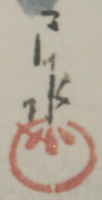 |
| Seal | Kawase seal (see above) |
| Publication Date | January 1931 original date of publication as printed in left margin 昭和六年一月 作 a work of Shōwa 6, 1st month |
| Edition | A posthumous (atozuri) edition made from the original blocks, bearing the 7mm circular "I"-type seal printed in black in the lower left of image. (For a fulldiscussion of Watanabe publisher sealssee "Watanabe Publisher Marks, Seals and Editions") |
| Publisher | 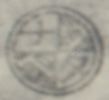 Watanabe "I"-type seal (in use from approximately 1957-present) reading (in katakana): ワタナベ Watanabe Shōzaburō |
| Printer | |
| Impression | excellent |
| Colors | excellent |
| Condition | excellent |
| Miscellaneous | |
| Genre | shin hanga (new prints) |
| Format | ōban tate-e |
| H x W Paper | 15 1/2 x 10 1/4 in. (39.4 x 26 cm) |
| H x W Image | 14 1/4 x 9 1/2 in. (36.2 x 24.1 cm) |
| Collections This Print | LosAngeles County Museum of Modern Art M73.37.103 (unidentified circularseal in lower left margin); The National Museum of Modern Art TokyoP00138-073 (unidentified circular seal in lower left corner); Museum ofFine Arts, Boston 49.400 (type E seal); Jordan Schnitzer Museum of Art MWJ51:K11 (type E seal) |
| Reference Literature | Kawase Hasui:TheComplete Woodblock Prints, (CatalogueRaisonné),Kendall Brown, Amy Reigle Newland, Hotei Publishing, KITPublishers, 2003, p. 88, pl. 245; Visions of Japan: Kawase Hasui's Masterpieces, Kendall H. Brown, Hotei Publishing, 2004, p.78 pl. 42; Source: Public Spectacles, Four Centuries of Japanese Prints from a Cincinnati Collection Personal Pleasures, by Alan Hockley, Cincinnati Art Museum, 2006, p. 111, fig. 79. |
8/19/2021


